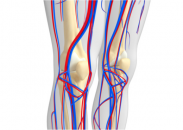Less than half of patients undergoing endovascular revascularization for peripheral artery disease to their lower limbs are discharged with optimal medical treatment. Their traditional risk factors are predictors of a more comprehensive treatment; however, women, patients with higher risk of thrombosis, and those more likely to lose a lower limb, are far from being treated…
ESC 2020 | Rivaroxaban Might Reduce Cardiac Cerebral and Peripheral Events
Adding rivaroxaban to the standard treatment might reduce events incidence in lower limbs, heart, and brain, in patients with peripheral vascular disease undergoing revascularization. These new data resulted from the analysis of the VOYAGER PAD subgroups and were presented at the virtual ESC 2020. The COMPASS study had reached similar conclusions using 2.5 mg rivaroxaban…
How to Determine Optimal Balloon Size in Below-the-Knee Angioplasty
Unlike the coronary and femoral arteries, calcification of medial layers in infrapatellar arteries prevents positive remodeling and expansion capacity to maintain vessel lumen. Long term patency of endovascular treatment is suboptimal despite the coated balloons, atherectomy devices and stents. Standard angiographies only show vessel lumen far from its real dimension given the severe thickening of…
Antiaggregation vs. Anticoagulation after Peripheral PCI
The truth is this question has no clear answer and what with do with peripheral stenting is transfer the evidence we have on coronary stenting, given the lack of standards and poor reporting on antithrombotic therapy outcomes in randomized studies on endovascular intervention. Heterogeneity is worse when it comes to venous territory. Some time ago…
New Device for More Protection in Carotid Artery Stenting
This new “Paladin” system for post-dilation during carotid artery stenting was safe and may effectively reduce the number of particles that reach the brain, with a subsequent decreased risk for peri-procedural stroke. This study evaluated the safety and efficacy of the Paladin System, a novel post-dilation balloon with an integrated distal protection filter designed to…
Mortality in Peripheral Vascular Disease Drops Due to Revascularization
This cohort study shows that, from 2006 to 2015, the overall survival rate increased and the risk of major amputation decreased following lower limb revascularization. These population observations indicate that outcomes after lower limb revascularization have improved during the assessed period, and so have the centralization and specialization of interventional services. The availability and diversity…
Balloon Angioplasty: A Reasonable Plan B for Chronic Thromboembolic Hypertension
Thromboembolic pulmonary hypertension is caused by pulmonary artery stenosis caused by organized thrombi. The only treatment potentially healing for this disease is surgical thrombectomy. However, patients with lesions in very peripheral branches or high surgical risk patients with comorbidities might benefit from a plan B, such as balloon pulmonary angioplasty. The percentage of patients with chronic…






